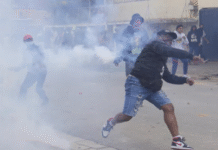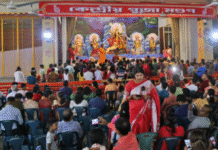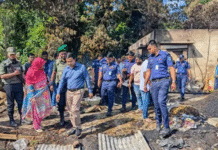
Rohingya refugees watch a food distribution at Balukhali refugee camp in Ukhiya on Wednesday. – AFP photo
Relief agencies on Wednesday continued fighting to contain outbreak of diseases among more than half a million half-starving Rohingyas, who entered Bangladesh fleeing violence in Myanmar to save life, as illness in their makeshift settlements was on the rise.
Directorate General of Health Services control room on Rohingyas showed that diseases like respiratory tract infection, diarrhoea, dysentery, skin diseases and others doubled in a week.
Over half a million Rohingyas, who entered Bangladesh fleeing violence, what the United Nations termed a textbook example of ethnic cleansing, in Rakhine state of Myanmar, put immense pressure on overcrowded health facilities while international health service providers warned of an outbreak of different water- and air-borne diseases.
‘Many sites are now alarmingly overcrowded, exacerbating risks to people’s security, safety and wellbeing. In these highly congested conditions there is an increasingly high risk of an outbreak of disease,’ said United Nations resident coordinator in Bangladesh Robert Watkins.
He made the comment in a statement on Wednesday in which the United Nations sought $434 million over the next six months to scale up humanitarian assistance for Rohingyas in Bangladesh, mostly children, in dire need of life-saving assistance.
‘The Rohingya Refugee Crisis Response Plan is focused on life-saving and protection assistance for the most vulnerable people. The Plan targets 1.2 million people, including all Rohingya refugees, and 300,000 Bangladeshi host communities over the next six months,’ he said.
The United Nations made the new appeal when United Nations Office for the Coordination of Humanitarian Affairs financial tracking service on Wednesday said that $44.6 million funding was received which was 58.2 per cent of $77.1 million, requested on September 7 to assist 300,000 Rohingyas till end of this year.
Bangladesh health officials said that they along with non-government organisations and international
aid groups provided indoor and outdoor treatment to about 95,000 Rohingyas in September and the first three days of October.
They, however, could not say whether all these patients took treatment once or more.
Service providers at Cox’s Bazar general hospital, upazila health complexes, community clinics, satellite clinics and aid providers’ clinics continued struggling to cope with the increasing number of patients.
Cox’s Bazar civil surgeon Abdus Salam said that the number of Rohingya patients were on the rise, as Rohingyas were coming for treatment in icreasing numbers and reporting system had improved.
‘Everything is under control, no outbreak or epidemic situation has emerged,’ he said, adding, ‘we are trying our best to provide primary healthcare.’
International aid groups and government health service providers called for adequate food, water and sanitation facilities for Rohingyas to avert an outbreak of diseases in Cox’s Bazar.
UN agencies on Tuesday estimated that 5,09,000 Rohingyas had so far fled to Bangladesh to save life since August 25, when the violence erupted in Rakhine.
Officials estimated that the new influx already took to 9.27 lakh the number of Myanmar people living in Bangladesh.
The ongoing ethnic cleansing began on August 25, when Arakan Rohingya Salvation Army reportedly attacked dozens of police posts and checkpoints and one military base in Rakhine. The insurgent group, however, said that it made the attacks to pre-empt military attacks on Rohingyas.
The United Nations said that the situation spiralled into the world’s fastest developing refugee emergency and a humanitarian and human rights nightmare.
Terrified, half-starved, exhausted Rohingyas continued arriving in Bangladesh in groups trekking through hills and crossing rough sea and the River Naf on boat and taking shelter wherever they could in Cox’s Bazar and Bandarban.
Many Rohingyas took shelter at makeshift camps in reserved forests, felling trees, setting up shanties digging slopes of hills, some of then took shelter at overcrowded registered and unregistered camps.
Health service providers said that half-starvation of malnourished ethnic minority people of Myanmar coupled with unhygienic living conditions in and around camps and under open sky were causing their increasing illness.
Directorate General of Health Services control room said that 612 Rohingya diarrhoea patients took treatment at health facilities on September 27. The number increased to 653 on September 30 and 2053 on Tuesday.
The number of dysentery patients was 231 on September 27 and 1,514 on Tuesday 3.
The number of patients of skin diseases was 407 on September 27, 576 on September 30 and 1,321 on Tuesday.
The number of patients of respiratory tract infections was 1,302 on September 27, 1,303 on September 30 and 3,579 on Tuesday. Most of them suffered from infections like tonsillitis, pneumonia and bronchitis, said Abdus Salam.
In camps lacking clean water or sanitation, an outbreak of water-borne disease seems imminent, UN migration agency International Organisation for Migration said in a statement on Wednesday.
‘In Cox’s Bazar, what started as a humanitarian crisis is slowly spiralling into a catastrophe of biblical proportions. Mud, torrential monsoon rains and a hostile terrain are bogging down delivery of aid to more than half a million Rohingya refugees fleeing violence in Myanmar,’ it said.
International Federation of Red Cross and Red Crescent Societies on September 29 and World Health Organisation on September 25 warned about the risk of an outbreak of diarrhoea in the makeshift Rohingya camps.
‘Water and sanitation is a major challenge which increases the risk of water-borne diseases, including cholera,’ WHO said in a situation report on September 25, adding, ‘56% water points from tube-wells extracting groundwater have been found to be contaminated at medium level of risk.’
Parliamentary standing committee on home ministry on Wednesday recommended expediting the biometric registration of Rohingyas at its meeting held at parliament complex.
In the meeting, the members proposed for setting up a special archive to preserve pictorial reports, torture images, video clippings, paper clippings related to Rohingyas and the activities on the welfare of Rohingyas to focus them in the global arena and for the future generations.
New Age correspondent in Cox’s Bazar reported that local people said that they saw large plume of smoke on the Myanmar side of the border opposite to Kangorpara and Unchiprang on Wednesday.
Agence France-Presse reported that Rohingyta refugees arriving in Bangladesh amid a fresh exodus from strife-torn Myanmar described whole villages being emptied and thousands marching to the border as security forces redouble efforts to drive remaining Muslims from their homes.
An estimated 10,000 more reportedly massed in Myanmar near a crossing point into Bangladesh, and were poised to join the hundreds of thousands of mainly Rohingyas seeking out survival in wretched camps over the border.
The spike in new arrivals — prompted by what Rohingyas say is a fresh drive to purge Muslims still in westernmost Rakhine state — casts doubt on a Myanmar proposal aired this week to start repatriating the persecuted minority.
Rakhine has been emptied of half of its Rohingya population in weeks, and more are on the move as insecurity presses them to leave villages that have so far been spared the worst of the violence ripping through the state.
New York-based Human Rights Watch on Wednesday said that Myanmar military summarily executed several dozen Rohingyas at Maung Nu village in Rakhine on August 27.
Witnesses said that Burmese soldiers had beaten, sexually assaulted, stabbed, and shot villagers who had gathered for safety in a residential compound.
‘All the horrors of the Burmese army’s crimes against humanity against the Rohingya are evident in the mass killings in Maung Nu village,’ said Phil Robertson, deputy Asia director at Human Rights Watch. These atrocities demand more than words from concerned governments; they need concrete responses with consequences.’
Source: New Age









